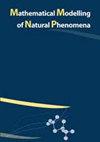血管端侧吻合仿真模型假设的合理选择
IF 2.1
4区 数学
Q2 MATHEMATICAL & COMPUTATIONAL BIOLOGY
引用次数: 3
摘要
血管表现出高度非线性、各向异性的行为,具有许多机械相互作用。由于所有相关影响的精确建模将产生计算上令人望而却步的程序,因此实用的临床模拟工具需要考虑相关因素的最小阈值。在这项研究中,我们分析了端侧吻合可靠模拟所需的建模假设。动脉壁在几何精确的设置中建模为预应力纤维增强复合材料。本研究的重点是与建模假设相关的吻合后应力场的敏感性分析。为此,对三种敏感情况进行了一组全尺寸有限元模拟:(i)在考虑和不考虑残余应力的情况下估计操作后的应力。(ii)检查受体血管中切口的不同几何形状。(iii)估计了材料刚度识别中的误差对操作后应力场的影响。所研究的案例(i)-(iii)表明,所考虑的建模假设对模拟的预测能力产生了重大影响。概述了更准确地预测操作后应力分布的方法,并寻求更准确的实验程序。作为副产品,对假性动脉瘤的发生进行了解释。本文章由计算机程序翻译,如有差异,请以英文原文为准。
Rational choice of modelling assumptions for simulation of blood vessel end-to-side anastomosis
Blood vessels exhibit highly nonlinear, anisotropic behaviour with numerous mechanical interactions. Since exact modelling of all involved effects would yield a computationally prohibitive procedure, a practical clinical simulation tool needs to account for a minimum threshold of relevant factors. In this study, we analyse needed modelling assumptions for a reliable simulation of the end-to-side anastomosis. The artery wall is modelled in a geometrically exact setting as a pre-stressed fibre-reinforced composite. The study focuses on the sensitivity analysis of post-anastomosis stress fields concerning the modelling assumptions. Toward that end, a set of full-scale finite element simulations is carried out for three sensitivity cases: (i) The post-operational stresses are estimated with and without taking the residual stresses into account. (ii) Different geometries of the cut in the recipient vessel are examined. (iii) The influence of errors in material stiffness identification on the post-operational stress field is estimated. The studied cases (i)---(iii) have shown a substantial impact of the considered modelling assumptions on the predictive capabilities of the simulation. Approaches to more accurate predictions of post-operational stress distribution are outlined, and a quest for more accurate experimental procedures is made. As a by-product, the occurrence of the pseudo-aneurysm is explained.
求助全文
通过发布文献求助,成功后即可免费获取论文全文。
去求助
来源期刊

Mathematical Modelling of Natural Phenomena
MATHEMATICAL & COMPUTATIONAL BIOLOGY-MATHEMATICS, INTERDISCIPLINARY APPLICATIONS
CiteScore
5.20
自引率
0.00%
发文量
46
审稿时长
6-12 weeks
期刊介绍:
The Mathematical Modelling of Natural Phenomena (MMNP) is an international research journal, which publishes top-level original and review papers, short communications and proceedings on mathematical modelling in biology, medicine, chemistry, physics, and other areas. The scope of the journal is devoted to mathematical modelling with sufficiently advanced model, and the works studying mainly the existence and stability of stationary points of ODE systems are not considered. The scope of the journal also includes applied mathematics and mathematical analysis in the context of its applications to the real world problems. The journal is essentially functioning on the basis of topical issues representing active areas of research. Each topical issue has its own editorial board. The authors are invited to submit papers to the announced issues or to suggest new issues.
Journal publishes research articles and reviews within the whole field of mathematical modelling, and it will continue to provide information on the latest trends and developments in this ever-expanding subject.
 求助内容:
求助内容: 应助结果提醒方式:
应助结果提醒方式:


